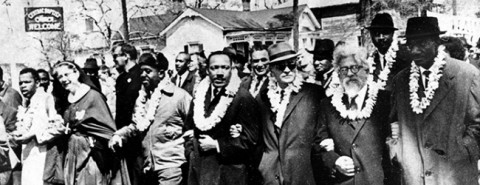Marching with prophets: Selma and the rise of an advocacy style

Fifty years ago, thousands marched across the Edmund Pettus Bridge in Selma, Alabama. They were led by an eye-catching row of marchers, including a bearded rabbi, an unidentified nun in flowing habit, and Martin Luther King Jr. The third Selma-to-Montgomery march, which began on March 21, 1965, is rightly remembered as a watershed in the struggle for civil rights. Less known is how Selma refocused the lives of many, black and white, who gave the march its spiritual hue.
The trek to Montgomery began with more than 3,000 of the civil rights faithful, whose ranks swelled by the thousands along the way. In that initial vanguard were several hundred clergy and untold numbers of lay religious activists from around the country. Voting rights became law five months later, just as many who had marched were letting loose their faith in a wider field of activism, taking on a host of social wrongs. They and others forged a new style of advocacy eventually known as the “prophetic style.”
Until the 1960s, white church people were easy to spot at a civil rights protest in the South because they were scarce. Standing out among them was William Sloane Coffin, the thirtysomething Yale chaplain and former CIA agent. In May 1961, Coffin made front-page news nationwide because he was white, well connected—and leading a group of Freedom Riders, who rode interracial buses across state lines to challenge segregated transportation in the Deep South. He emerged as the brash young face of incipient white solidarity with southern blacks.




